Winner of the 2021 WLA Awards – Editor’s Award
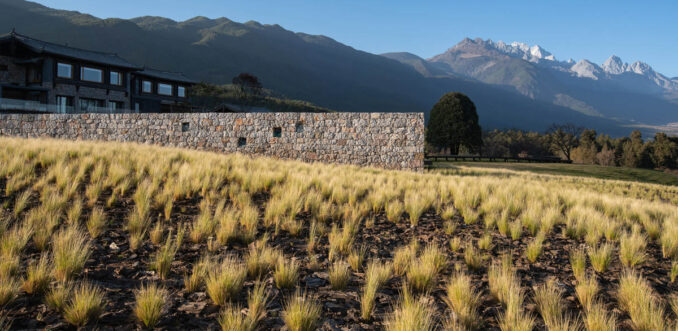
Within Pan-Himalaya Region, Alpine Garden is situated on the hillside of Jade Dragon Snow Mountain in Lijiang, Yunnan province, China, at an altitude of 2560m high. The 4-hectare site sits close to UNESCO World Heritage Sites, Yuhu historic village in the north and Baisha historic town in the east which can be overlooked from the alpine garden. It was created from an ancient Naxi village, which has been abandoned for several decades. This new garden was created to showcase the long history of Naxi culture and significant native alpine plants.
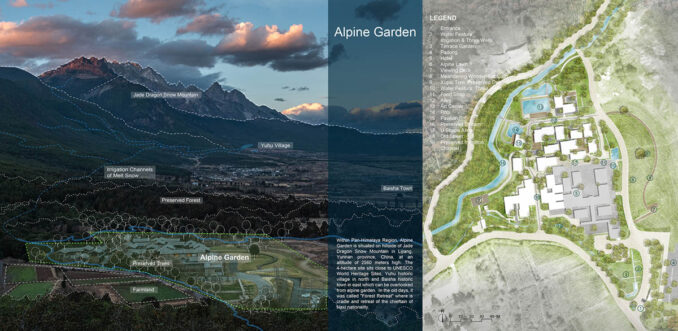
Vision
A slice of modernism in a rustic environment, Alpine Garden challenges the notion of contemporary design in a rugged alpine site surrounded by a grand landscape. Respect for the natural and cultural landscape is evident through the recreation of the 4-hectare derelict site, encouraging the visitors to fully immerse in the humbly designed environment with melt snow water, native vegetation and rich habitat.
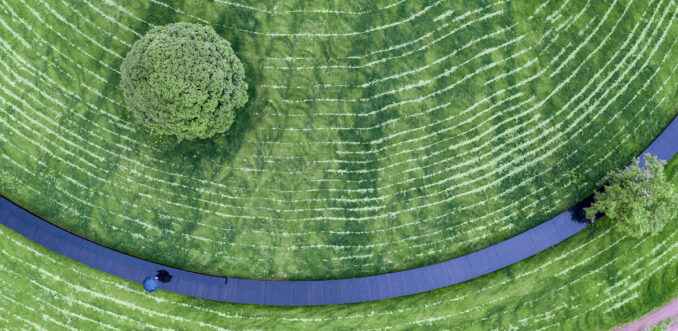
By preserving onsite heritage, landscape architects were on a mission to redefine visitor experience to attract more people to fund the project to make it economically sustainable. In a rapidly changing world, globalization is expanding to Lijiang to wipe off the remains of the Naxi culture with what we called modern civilization, little by little. Blending old Naxi and contemporary design serves as a strong educational and interactive landscape place to demonstrate the importance of Naxi garden tradition, native plants, rich local stone materials, and a new spatial experience. It is also the best garden in Lijiang to enjoyed the snowcapped glacier and overlook Baisha historic town.
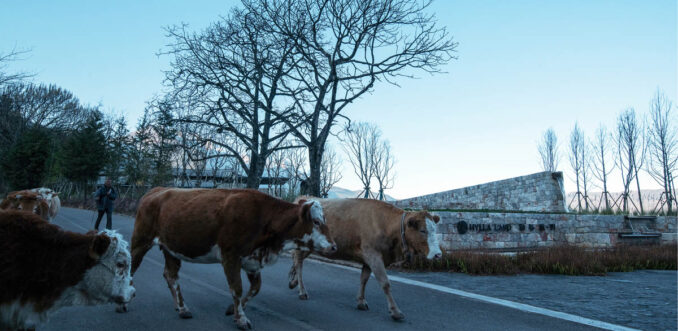
Preserve Cultural and Native Plants
It is said that Naxi people always surround an evergreen tree which is called Xupai to build their homes and create their village, because they believe that Xupai has some kinds of natural forces to protect their land from generation to generation.
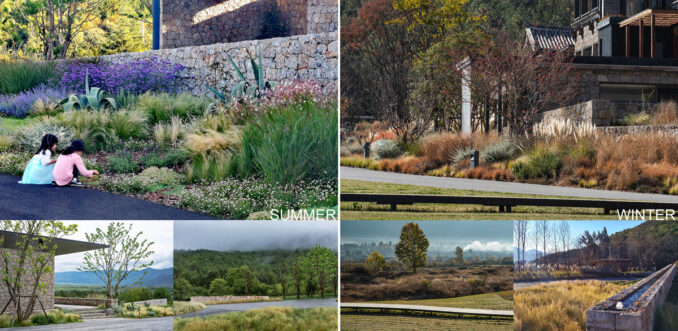
The spiritual Xupai of the alpine garden is a large, aged oak tree with 8 thick branches that resides at the center of the site for hundreds of years. The design team carefully kept it untouched and used it as a visual focal point to create a culturally sensitive landscape that blends together new and old seamlessly. Visitors start their walk from a long white stone wall, then step down on a long meandering black wooden path to interact with Xupai in the majestic beauty and tranquillity. In response to the surrounding farmland context, the meandering wooden footpath leaded visitors through a characteristic alpine lawn which mixed with shamrocks to symbolize linear ridges of a wheat field. The alpine lawn with Xupai at the center serves as a gathering and event space where people enjoy dancing, singing, reading, viewing. It provides the best vantage point to appreciate grand Jade Dragon Snow Mountain and overlooks Baisha historic town.
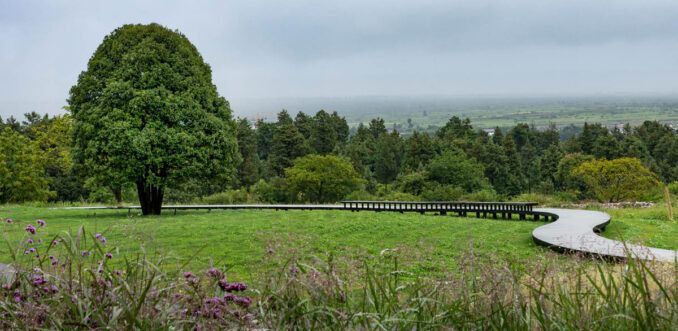
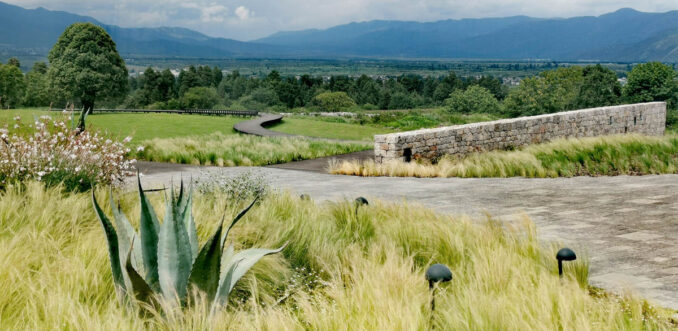
Preserve Local Stones and Craftsmanship
With uncompromising craftsmanship, local stonemasons and carpenters carried out all stone and wood related works. By using traditional technics to carve and stack, they deliberately remain all subtle texture details on every stone while the design form is contemporary and simple. It sends visitors a clear message that the alpine garden is strongly connected to Naxi culture in Lijiang and has its own uniqueness.
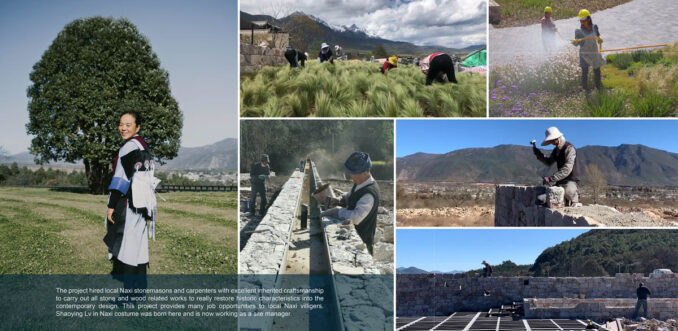
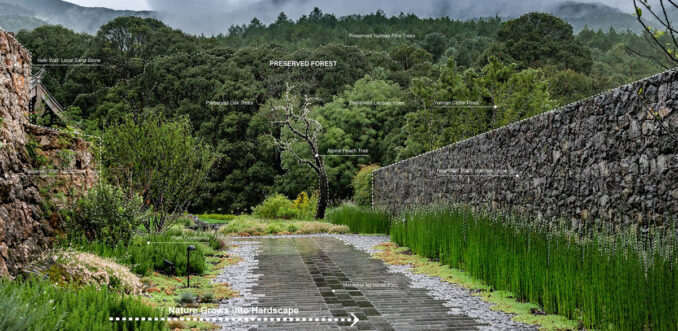
Water Feature as a Metaphor for Historic Water Elements
The water features were conceived as an abstracted reference to the historic Three Wells and irrigation canal. Three Wells represents the wisdom of Naxi people to make good use of melted snow cascading down snow mountains and into the irrigation channels. The upper well is drinking water for local residents, the middle well is used to wash vegetables and fruits, the lower well is used to wash clothes, the outflow water is to irrigate nearby farmland. The design team integrates the Three Wells concept into water features of both entrance and canteen.
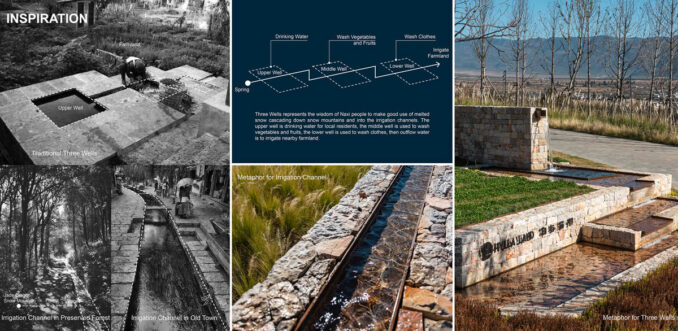
Collecting water from melt snow, the 35m long water channel wall is not only constructed as a retaining wall to sort out the level difference between road and terrace, but also a metaphor for traditional irrigation channel. The design team integrates the Three Wells concept into water features of both entrance and canteen, where waterfalls three times. Red Guifeng stones are placed at the bottom of the pool, and black slates are used as the transition. It reflects a deep respect for the place and its inherent beauty, a raw elegance that is emphasized through the design’s forms, materials, and textures.
The use of shadows, textures, and subtle colors enhances the inherent beauty of the large landscape space and gives visitors a sense of place for both traditional and contemporary Lijiang.
Alpine Garden Preserve Indigenous Culture and Native Plants
Landscape Architect: Z’scape
Lead Designers: Liangjun Zhou, Ting Zhou
Landscape Designers: Hao Yu, Liping Chen, Weiguang Hou, Hongjie Shi, Xueting Liu, Junxing Lv, Pei Han, Fang Qin, Chang Sun, Huiting Shi, Zijian Wang,Qiuyu Zhang,Jingzhi Du,Yueheng Liu, Zhenhua Yang, Jiaqi Liu, Jie Chen, Meng Zhang, Wei Dong(intern), Zilan Wang(intern)
Client: HYLLA GROUP
Client Coordinators: Qiujin Hu, Fei Yang,Qiaohou He
Local Stonemasons: Lijiang Cairunhong Engineering Co., Ltd.
Local Carpenters: Shangri-La Hongmutang Traditional Wood Structure Co., Ltd.
Planting Consultant: Chengdu Shangye Horticulture Co., Ltd.
Lighting Consultant: Zhou Hongliang Lighting Design Beijing Co., Ltd.
Planning Consultant: Beijing Guanhe Shifang Consulting Co., Ltd
Landscape Contractor: Sichuan Xingli Garden Environment Engineering Co., Ltd.
Image Credits: as captioned
